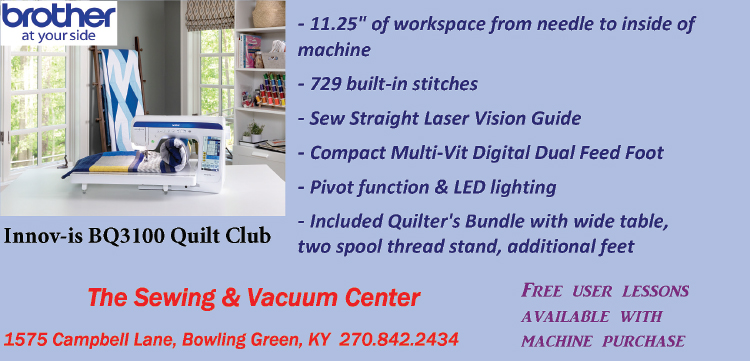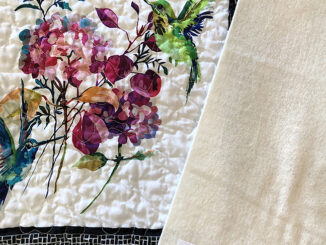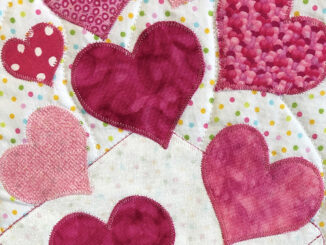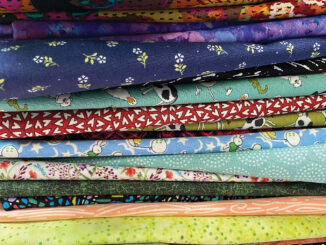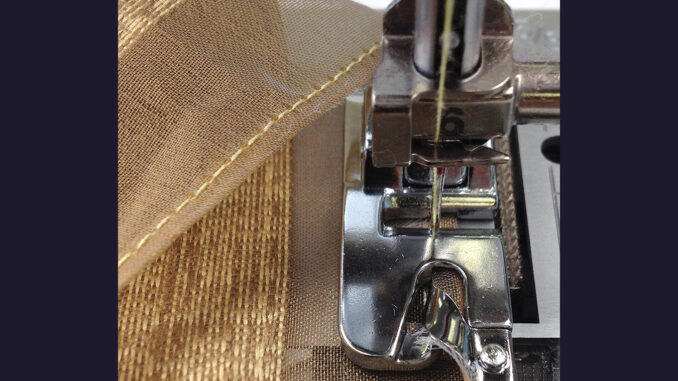
In Part I, we looked at the machine feet that generally come with the purchase of a machine. In this article, we’ll look at additional feet that are usually add-on purchases with your machine; however, many high-end machines will have some of these feet included.
Even-feed or walking foot: I use this foot a lot – I consider it a “basic” foot. This foot is designed to sew multiple layers of fabric together without the top layer shifting. The foot has a set of feed dogs, similar to what your throat plate has, that helps pull the top layer through the machine at the same rate as the bottom layer. This is useful for stitching plaids, checks, strips, satins, etc. This foot is also great to use for straight-line quilting. Some machine models have a built-in walking foot and some Brother machines have a belt-driven walking foot that produces very smooth results.
¼” Quarter-Inch or Piecing Foot: This foot allows the sewer to accurately stitch a ¼” seam, which is essential in quilt making. This can be useful in garment making for constructing a French seam and is also good for craft sewing where smaller seams are used.
Button foot: Yes, you can sew buttons on with the machine! The foot holds the button securely in place as you stitch (using a zigzag) through the eyes. A great time-saver for the sewing room.
Braiding or Couching Foot: Used for embellishment, the braiding foot has a hole in the foot which allows the decorative braid, cord, etc. to be threaded through and passed under the foot. This holds the embellishment in place as it is stitched. Some feet may be adjustable to accommodate different sizes of braid, etc. Depending on the foot, either a straight or zigzag stitch is used to attach the cording, ribbon, etc. to your project.
Cording Foot: One, two, or three lengths of cord can be placed in this foot and stitched to project for embellishment. Try a combination of cordings for a different look. A stitch with a zigzag or decorative stitch is used to hold cords in place.
Gathering Foot: This foot will gently gather or ease fabrics to another. For gathering, this works best with lightweight fabrics such as batiste or lawn.
Ruffler: If full gathers are what you are looking for, this is the foot you need. The ruffler makes very full gathers in your fabrics. Ruffled finishes on curtains, bed skirts, etc. are made with this attachment.
Narrow Hem or “Shirttail” Hem Foot: Used to create a narrow, rolled hem on lightweight fabrics. Be sure to test your fabric/needle/thread combinations before stitching your hem for best results!
Pintuck Foot: This foot creates delicate pintucks in fine fabrics such as batiste and lawn. The underside of the foot is grooved with five, seven, or nine channels that create the pintucks. A twin or double needle along with a lightweight thread is used with the foot to create the tucks.
Free Motion Quilting Foot: This foot is used when quilting with the feed dogs in the dropped position. The machine operator controls the movement of the fabric, not the machine. This foot can either “hop” or glide across the fabric, depending on the type the machine company supplies with the machine. A must-have for free motion work.
Adding a variety of feet to your sewing notions can increase the versatility of your sewing experience. After using some of these, you will wonder how you managed to stitch without them!
Remember that if you purchase a machine from The Sewing & Vacuum Center, you receive free lessons on your machine, including how to use the many feet that are included with the machine.
-submitted by The Sewing & Vacuum Center

